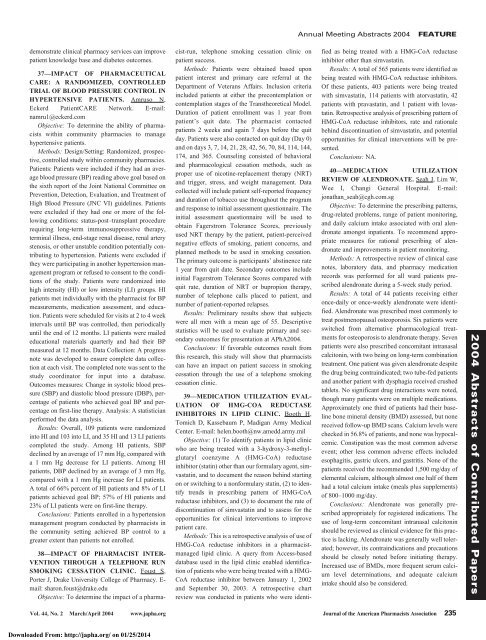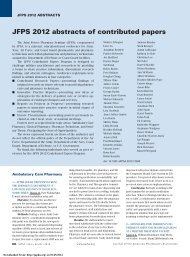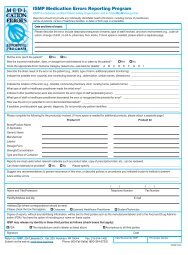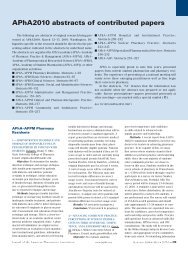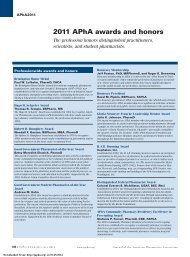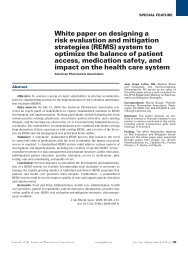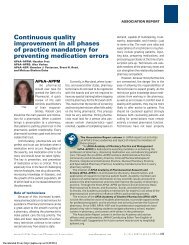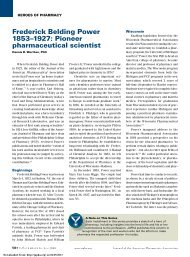Downloaded - Journal of American Pharmacists Association
Downloaded - Journal of American Pharmacists Association
Downloaded - Journal of American Pharmacists Association
You also want an ePaper? Increase the reach of your titles
YUMPU automatically turns print PDFs into web optimized ePapers that Google loves.
Annual Meeting Abstracts 2004<br />
FEATURE<br />
demonstrate clinical pharmacy services can improve<br />
patient knowledge base and diabetes outcomes.<br />
37—IMPACT OF PHARMACEUTICAL<br />
CARE: A RANDOMIZED, CONTROLLED<br />
TRIAL OF BLOOD PRESSURE CONTROL IN<br />
HYPERTENSIVE PATIENTS. Amruso N,<br />
Eckerd PatientCARE Network. E-mail:<br />
namru1@eckerd.com<br />
Objective: To determine the ability <strong>of</strong> pharmacists<br />
within community pharmacies to manage<br />
hypertensive patients.<br />
Methods: Design/Setting: Randomized, prospective,<br />
controlled study within community pharmacies.<br />
Patients: Patients were included if they had an average<br />
blood pressure (BP) reading above goal based on<br />
the sixth report <strong>of</strong> the Joint National Committee on<br />
Prevention, Detection, Evaluation, and Treatment <strong>of</strong><br />
High Blood Pressure (JNC VI) guidelines. Patients<br />
were excluded if they had one or more <strong>of</strong> the following<br />
conditions: status-post–transplant procedure<br />
requiring long-term immunosuppressive therapy,<br />
terminal illness, end-stage renal disease, renal artery<br />
stenosis, or other unstable condition potentially contributing<br />
to hypertension. Patients were excluded if<br />
they were participating in another hypertension management<br />
program or refused to consent to the conditions<br />
<strong>of</strong> the study. Patients were randomized into<br />
high intensity (HI) or low intensity (LI) groups. HI<br />
patients met individually with the pharmacist for BP<br />
measurements, medication assessment, and education.<br />
Patients were scheduled for visits at 2 to 4 week<br />
intervals until BP was controlled, then periodically<br />
until the end <strong>of</strong> 12 months. LI patients were mailed<br />
educational materials quarterly and had their BP<br />
measured at 12 months. Data Collection: A progress<br />
note was developed to ensure complete data collection<br />
at each visit. The completed note was sent to the<br />
study coordinator for input into a database.<br />
Outcomes measures: Change in systolic blood pressure<br />
(SBP) and diastolic blood pressure (DBP), percentage<br />
<strong>of</strong> patients who achieved goal BP and percentage<br />
on first-line therapy. Analysis: A statistician<br />
performed the data analysis.<br />
Results: Overall, 109 patients were randomized<br />
into HI and 103 into LI, and 35 HI and 13 LI patients<br />
completed the study. Among HI patients, SBP<br />
declined by an average <strong>of</strong> 17 mm Hg, compared with<br />
a 1 mm Hg decrease for LI patients. Among HI<br />
patients, DBP declined by an average <strong>of</strong> 3 mm Hg,<br />
compared with a 1 mm Hg increase for LI patients.<br />
A total <strong>of</strong> 66% percent <strong>of</strong> HI patients and 8% <strong>of</strong> LI<br />
patients achieved goal BP; 57% <strong>of</strong> HI patients and<br />
23% <strong>of</strong> LI patients were on first-line therapy.<br />
Conclusions: Patients enrolled in a hypertension<br />
management program conducted by pharmacists in<br />
the community setting achieved BP control to a<br />
greater extent than patients not enrolled.<br />
38—IMPACT OF PHARMACIST INTER-<br />
VENTION THROUGH A TELEPHONE RUN<br />
SMOKING CESSATION CLINIC. Foust S,<br />
Porter J, Drake University College <strong>of</strong> Pharmacy. E-<br />
mail: sharon.foust@drake.edu<br />
Objective: To determine the impact <strong>of</strong> a pharmacist-run,<br />
telephone smoking cessation clinic on<br />
patient success.<br />
Methods: Patients were obtained based upon<br />
patient interest and primary care referral at the<br />
Department <strong>of</strong> Veterans Affairs. Inclusion criteria<br />
included patients at either the precontemplation or<br />
contemplation stages <strong>of</strong> the Transtheoretical Model.<br />
Duration <strong>of</strong> patient enrollment was 1 year from<br />
patient’s quit date. The pharmacist contacted<br />
patients 2 weeks and again 7 days before the quit<br />
day. Patients were also contacted on quit day (Day 0)<br />
and on days 3, 7, 14, 21, 28, 42, 56, 70, 84, 114, 144,<br />
174, and 365. Counseling consisted <strong>of</strong> behavioral<br />
and pharmacological cessation methods, such as<br />
proper use <strong>of</strong> nicotine-replacement therapy (NRT)<br />
and trigger, stress, and weight management. Data<br />
collected will include patient self-reported frequency<br />
and duration <strong>of</strong> tobacco use throughout the program<br />
and response to initial assessment questionnaire. The<br />
initial assessment questionnaire will be used to<br />
obtain Fagerstrom Tolerance Scores, previously<br />
used NRT therapy by the patient, patient-perceived<br />
negative effects <strong>of</strong> smoking, patient concerns, and<br />
planned methods to be used in smoking cessation.<br />
The primary outcome is participants’ abstinence rate<br />
1 year from quit date. Secondary outcomes include<br />
initial Fagerstrom Tolerance Scores compared with<br />
quit rate, duration <strong>of</strong> NRT or bupropion therapy,<br />
number <strong>of</strong> telephone calls placed to patient, and<br />
number <strong>of</strong> patient-reported relapses.<br />
Results: Preliminary results show that subjects<br />
were all men with a mean age <strong>of</strong> 55. Descriptive<br />
statistics will be used to evaluate primary and secondary<br />
outcomes for presentation at APhA2004.<br />
Conclusions: If favorable outcomes result from<br />
this research, this study will show that pharmacists<br />
can have an impact on patient success in smoking<br />
cessation through the use <strong>of</strong> a telephone smoking<br />
cessation clinic.<br />
39—MEDICATION UTILIZATION EVAL-<br />
UATION OF HMG-COA REDUCTASE<br />
INHIBITORS IN LIPID CLINIC. Booth H,<br />
Tomich D, Kassebaum P, Madigan Army Medical<br />
Center. E-mail: helen.booth@nw.amedd.army.mil<br />
Objective: (1) To identify patients in lipid clinic<br />
who are being treated with a 3-hydroxy-3-methylglutaryl<br />
coenzyme A (HMG-CoA) reductase<br />
inhibitor (statin) other than our formulary agent, simvastatin,<br />
and to document the reason behind starting<br />
on or switching to a nonformulary statin, (2) to identify<br />
trends in prescribing pattern <strong>of</strong> HMG-CoA<br />
reductase inhibitors, and (3) to document the rate <strong>of</strong><br />
discontinuation <strong>of</strong> simvastatin and to assess for the<br />
opportunities for clinical interventions to improve<br />
patient care.<br />
Methods: This is a retrospective analysis <strong>of</strong> use <strong>of</strong><br />
HMG-CoA reductase inhibitors in a pharmacistmanaged<br />
lipid clinic. A query from Access-based<br />
database used in the lipid clinic enabled identification<br />
<strong>of</strong> patients who were being treated with a HMG-<br />
CoA reductase inhibitor between January 1, 2002<br />
and September 30, 2003. A retrospective chart<br />
review was conducted in patients who were identified<br />
as being treated with a HMG-CoA reductase<br />
inhibitor other than simvastatin.<br />
Results: A total <strong>of</strong> 565 patients were identified as<br />
being treated with HMG-CoA reductase inhibitors.<br />
Of these patients, 403 patients were being treated<br />
with simvastatin, 114 patients with atorvastatin, 42<br />
patients with pravastatin, and 1 patient with lovastatin.<br />
Retrospective analysis <strong>of</strong> prescribing pattern <strong>of</strong><br />
HMG-CoA reductase inhibitors, rate and rationale<br />
behind discontinuation <strong>of</strong> simvastatin, and potential<br />
opportunities for clinical interventions will be presented.<br />
Conclusions: NA.<br />
40—MEDICATION UTILIZATION<br />
REVIEW OF ALENDRONATE. Seah J, Lim W,<br />
Wee I, Changi General Hospital. E-mail:<br />
jonathan_seah@cgh.com.sg<br />
Objective: To determine the prescribing patterns,<br />
drug-related problems, range <strong>of</strong> patient monitoring,<br />
and daily calcium intake associated with oral alendronate<br />
amongst inpatients. To recommend appropriate<br />
measures for rational prescribing <strong>of</strong> alendronate<br />
and improvements in patient monitoring.<br />
Methods: A retrospective review <strong>of</strong> clinical case<br />
notes, laboratory data, and pharmacy medication<br />
records was performed for all ward patients prescribed<br />
alendronate during a 5-week study period.<br />
Results: A total <strong>of</strong> 44 patients receiving either<br />
once-daily or once-weekly alendronate were identified.<br />
Alendronate was prescribed most commonly to<br />
treat postmenopausal osteoporosis. Six patients were<br />
switched from alternative pharmacological treatments<br />
for osteoporosis to alendronate therapy. Seven<br />
patients were also prescribed concomitant intranasal<br />
calcitonin, with two being on long-term combination<br />
treatment. One patient was given alendronate despite<br />
the drug being contraindicated; two tube-fed patients<br />
and another patient with dysphagia received crushed<br />
tablets. No significant drug interactions were noted,<br />
though many patients were on multiple medications.<br />
Approximately one third <strong>of</strong> patients had their baseline<br />
bone mineral density (BMD) assessed, but none<br />
received follow-up BMD scans. Calcium levels were<br />
checked in 56.8% <strong>of</strong> patients, and none was hypocalcemic.<br />
Constipation was the most common adverse<br />
event; other less common adverse effects included<br />
esophagitis, gastric ulcers, and gastritis. None <strong>of</strong> the<br />
patients received the recommended 1,500 mg/day <strong>of</strong><br />
elemental calcium, although almost one half <strong>of</strong> them<br />
had a total calcium intake (meals plus supplements)<br />
<strong>of</strong> 800–1000 mg/day.<br />
Conclusions: Alendronate was generally prescribed<br />
appropriately for registered indications. The<br />
use <strong>of</strong> long-term concomitant intranasal calcitonin<br />
should be reviewed as clinical evidence for this practice<br />
is lacking. Alendronate was generally well tolerated;<br />
however, its contraindications and precautions<br />
should be closely noted before initiating therapy.<br />
Increased use <strong>of</strong> BMDs, more frequent serum calcium<br />
level determinations, and adequate calcium<br />
intake should also be considered.<br />
2004 Abstracts <strong>of</strong> Contributed Papers<br />
Vol. 44, No. 2 March/April 2004 www.japha.org <strong>Journal</strong> <strong>of</strong> the <strong>American</strong> <strong>Pharmacists</strong> <strong>Association</strong> 235<br />
<strong>Downloaded</strong> From: http://japha.org/ on 01/25/2014


